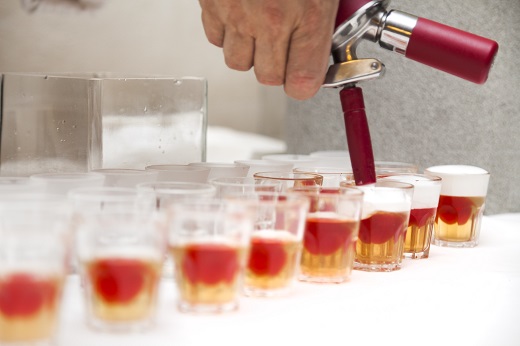Food science—as its name suggests—is a study devoted to understanding the industrial production of food. This includes research into the safety, preservation, and chemical composition▼ of food. As a result, the variety and amount of food has greatly increased. Until molecular gastronomy started introducing new ways to apply chemistry and physics to food preparation, how people prepare food changed very little from the ways our ancestors did it for thousands of years.
Before the invention of the microwave oven, food all around the world was prepared the same way over countless generations. The only ways to cook food were by using heat from direct or indirect exposure to fire—such as baking, roasting, frying, or barbecuing—or from heated water—such as boiling or steaming. In stark▼ contrast, the modern molecular gastronomy kitchen looks like a cross between a kitchen and a science lab. That is because food undergoes preparation and treatment that requires great precision, as well as technical tools which are unavailable in traditional kitchens. Molecular gastronomy experiments with processes applied to food that attempt to extract flavors and change the textures▼ of food. This may sound like a Frankenstein approach to cooking, but it relies on good old 100% natural ingredients. Everything used is from biological sources, whether plant or animal.
What is the result of this intense interest in and experimentation▼ with food? Some very surprising dishes! Transparent▼ ravioli▼, mango purée▼ served as a sphere, and caviar▼ made from olive oil are just a few out-of-the-box▼ ideas created in molecular gastronomy kitchens. Only time will tell whether molecular gastronomy is just a fad or the wave of the future.
------------------------------------------------------ 1. What is the main purpose of this article?
(A) To give a history of the development of molecular gastronomy.
(B) To detail recipes used in molecular gastronomy cooking.
(C) To point out the differences between traditional and molecular gastronomy kitchens.
(D) To explain a new style of science-based cooking.
------------------------------------------------------ 2. According to the article, why has the amount of food increased greatly in modern times?
(A) Food science has focused on the production of more food.
(B) The purpose of molecular gastronomy has been to increase the food supply.
(C) With the increase in restaurants worldwide, more food is being produced.
(D) Natural ingredients and food sources are more plentiful13 than man-made ones.
------------------------------------------------------ 3. Why are microwave ovens mentioned in the second paragraph?
(A) It was the first invention of the molecular gastronomy kitchen.
(B) It was the first new way to cook food in the modern age.
(C) Microwave cooking developed from molecular gastronomy cooking.
(D) Like molecular gastronomy cooking methods, heat is not necessary in a microwave.
------------------------------------------------------ 4. What seems to be the writer’s opinion of molecular gastronomy cooking?
(A) It is just a passing fad.
(B) In the future, only microwave cooking will be used.
(C) In the future, all cooking will be done by molecular gastronomy methods.
(D) Its future is uncertain. 

| 

沒有留言:
張貼留言